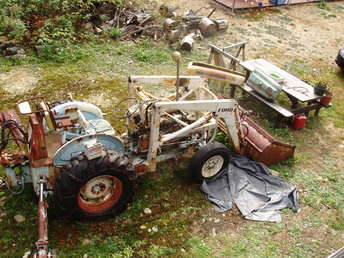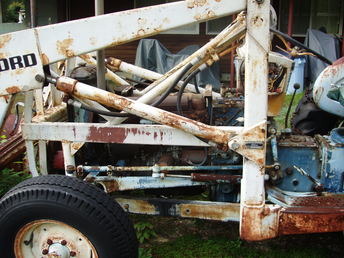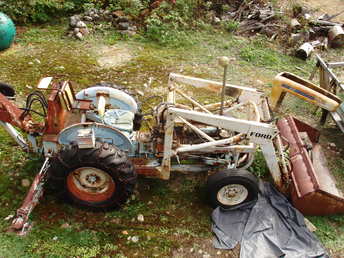just want to start work on my 4000 industrial tractor.want to rebuild motor, wondering if loader removal is a big job without tractor running? am I going to have to drain oil from frame of loader? have access to friends bucket loader to help in loader removal. any help would be appreciated.
You are using an out of date browser. It may not display this or other websites correctly.
You should upgrade or use an alternative browser.
You should upgrade or use an alternative browser.
- Thread starter Glen
- Start date
Anonymous-0
Well-known Member
Have not done it on my 850 yet, but have contemplated it, thinking I've got a noisy throw out bearing or pilot bearing, can see a split being inevitable if that is true. It would seem you need to unhook the back end, probably makes it easy if you can hook onto it from above, prior to, then unhook the front end, you have to deal with the hoses, front pump and or tractor hydraulics, just a bulky thing to deal with once ready to move, that other loader is going to be very helpful. Hard to say about the hydraulic oil, this one has an external reservoir, but the frame was the reservoir when built, would think it would be contained unless a hose was situated to drain it out, good time to change it or plug any openings.
Most important, be safe when doing a job like this, don't pinch a hand, finger or put yourself under it, use solid hardwood cribbing for blocking if needed, common sense will get it done and keep you out of trouble.
Most important, be safe when doing a job like this, don't pinch a hand, finger or put yourself under it, use solid hardwood cribbing for blocking if needed, common sense will get it done and keep you out of trouble.
woodbutcher
Well-known Member
Hi Glen,
I recently removed an industrial fel from my 3-cyl. 4000. Then I installed it on my 4500. The first thing I did was to remove the bucket to make it as light as possible. Then I took off the tilt cylinders. This loader is an older MF commercial loader, so I drained the oil from the frame reservoir. Then it was a matter of supporting the frame and removing the frame bolts from the nose of the tractor and from the axle support/fenders. I used a bois'd'arc tree to raise the fel when the time came and jacks under the frame halfway between the axle and the front of the frame.
Butch
I recently removed an industrial fel from my 3-cyl. 4000. Then I installed it on my 4500. The first thing I did was to remove the bucket to make it as light as possible. Then I took off the tilt cylinders. This loader is an older MF commercial loader, so I drained the oil from the frame reservoir. Then it was a matter of supporting the frame and removing the frame bolts from the nose of the tractor and from the axle support/fenders. I used a bois'd'arc tree to raise the fel when the time came and jacks under the frame halfway between the axle and the front of the frame.
Butch
Glen
Not sure how you could rebuild the motor without pulling the loader. I just rebuilt the lower frame on my FEL loader on my 2600 and while its not fun its possible to remove in probably 4 hours. On mine I have to remove hoses to get the loader off with adds to the mess on the floor.
Here's a picture of when I pulled a loader off my 2n. At that time I had few tools and I was able to pull it by unbolting it, and then jacking parts of it up and slowy moving the tractor out from under it. There were numerous steps involved and I've moved a lot of heavy industrial equipment but it shows what you can do with 2 jacks and a pile of wood blocks. If you have someone with a loader to help that would be very helpful

Not sure how you could rebuild the motor without pulling the loader. I just rebuilt the lower frame on my FEL loader on my 2600 and while its not fun its possible to remove in probably 4 hours. On mine I have to remove hoses to get the loader off with adds to the mess on the floor.
Here's a picture of when I pulled a loader off my 2n. At that time I had few tools and I was able to pull it by unbolting it, and then jacking parts of it up and slowy moving the tractor out from under it. There were numerous steps involved and I've moved a lot of heavy industrial equipment but it shows what you can do with 2 jacks and a pile of wood blocks. If you have someone with a loader to help that would be very helpful

steve n carol
Member
Glen, I have only split one tractor-only one time. This was my 4500 w/FEL and a Gannon Scraper on the rear. The loader has a frame that incorporates the rear axle.
This was to rebuild the 3 cyl diesel engine. It was not running. I lifted the gannon w/another loader and propped it up on the tractor frame so it was off of the ground. I next raised the loader w/bucket and put 2- 3"x3"x28" angle irons on the raised cylinders, lowered the loader to the angle irons. I also used a couple of hose clamps to insure that the angle irons stayed in place. I then made vertical support/s to put under the loader just behind the bucket. I was then able to remove the front cowl, etc and front axle using the bucket end of the loader as a gantry :lol: I was also able to use this 'gantry' to R&R the engine
tom stalker
Member
john_Bud knows the Industrial fords inside - out.
He has a few of them and has done a lot of work on them. He has helped me. I would contact him.
He has a few of them and has done a lot of work on them. He has helped me. I would contact him.
Operator4100
Member
Hey, Just did mine a couple of weeks ago, Another loader would be very helpfull, I did mine with an engine hoist it can be done just be safe and watch those pinch points
img]https://photos.yesterdaystractors.com/gallery/uptest/a1381.jpg[/img](quoted from post at 10:23:36 01/29/09) just want to start work on my 4000 industrial tractor.want to rebuild motor, wondering if loader removal is a big job without tractor running? am I going to have to drain oil from frame of loader? have access to friends bucket loader to help in loader removal. any help would be appreciated.


Hi Glen. (didn't notice this before, sorry)
Do you have access to a lot of 3/4" plywood? Or are you going to move that tractor onto some cement? A solid surface that won't allow jacks, jack stands, hoists, blocking etc to sink is in my opinion a 100% needed thing. When I've HAD to use wood on earth, I put sheet metal on top of the wood so the steel roller wheels on the floor jack don't sink in.
There is just too much risk of a 1200 pound chunk of steel landing on your head to not take precautions. Just my opinion, but I do 99% of my stuff alone and hours and hours from any one coming to check on me. (Not too smart, eh?)
On to your question. You don't need the engine running. You will need to be able to manipulate the loader up down and around safely. I use a combination of 2.5 ton floor roll around jack, 6 ton bottle jacks, 3 sets of jack stands, various wood cribbing (6"x12"x24" is my favorite) and an engine hoist that can lift 2000 pounds when at full extension.
I would put the engine hoist to hold up the front and disconnect that (use cribbing to keep it from squashing your brain box should it fall). Then take the connection off the rear axle. You should have already removed any hydraulics or other things connecting to the tractor. Then lower the front. I would probably put it onto a wood "sled" that would allow you to slide the whole deal forward. Lower the rear to the ground. Use straps to connect the bucket to the front and then pull it out of the way.
I would also go to the closest GM dealer and buy some "Heat Pipe Lubricant" it's about 9 - 10 bucks for a 12 oz blue can. The stuff is both a rust remover and a penetrant. It's 10x better than PB Blaster and 2x better than Kroil. It's what the techs use and they are on the clock and don't have time to diddle with stuck fasteners. Soak down all the nuts, bolts 3 times a day for at least a couple days. Then get your Ox/Ac tanks filled and clean the rosebud. There WILL be at least one bolt that will need some warmth to get loose even with penetrant. Or maybe it's just my stuff that acts that way?
The other thing is that you will pretty much be better off if you remove the backhoe first. If you can't (engine won't run or even crank), then lift the hoe main box and set it onto SOLID blocking. Make sure the bucket is on solid surface (at least 3/4 plywood). You really really really really don't want to have the hoe flip your rear end onto its side. Really really don't want that. You will need to put a stout jack stand under the transmission so it won't tip forward.
I like to roll the back half away, but if the BH is on there you will have to move the engine half forward.
When you put it back together, get some 6" long bolts and cut the heads off. Thread them into the engine at the 3 and 9 o'clock positions. Use them to help guide the parts into correct alignment. Never use bolt force to pull the parts together. You will ABCDEF it up, if you get my point. You may have to hand rotate the engine slightly back and forth to get the splines to line up and slide in. An engine tilt tool from Harbor Freight will be a help. It's a screw movable lift point that you crank to tilt the engine up or down slightly. Much smarter than laying on the ground under the engine pulling it down on one end and trying to shove it around.
hanks john_bud...I really needed that input to get ready for the project.and you definitely answered my worries about stabilizing the backhoe.(quoted from post at 22:05:05 02/07/09)
Hi Glen. (didn't notice this before, sorry)
Do you have access to a lot of 3/4" plywood? Or are you going to move that tractor onto some cement? A solid surface that won't allow jacks, jack stands, hoists, blocking etc to sink is in my opinion a 100% needed thing. When I've HAD to use wood on earth, I put sheet metal on top of the wood so the steel roller wheels on the floor jack don't sink in.
There is just too much risk of a 1200 pound chunk of steel landing on your head to not take precautions. Just my opinion, but I do 99% of my stuff alone and hours and hours from any one coming to check on me. (Not too smart, eh?)
On to your question. You don't need the engine running. You will need to be able to manipulate the loader up down and around safely. I use a combination of 2.5 ton floor roll around jack, 6 ton bottle jacks, 3 sets of jack stands, various wood cribbing (6"x12"x24" is my favorite) and an engine hoist that can lift 2000 pounds when at full extension.
I would put the engine hoist to hold up the front and disconnect that (use cribbing to keep it from squashing your brain box should it fall). Then take the connection off the rear axle. You should have already removed any hydraulics or other things connecting to the tractor. Then lower the front. I would probably put it onto a wood "sled" that would allow you to slide the whole deal forward. Lower the rear to the ground. Use straps to connect the bucket to the front and then pull it out of the way.
I would also go to the closest GM dealer and buy some "Heat Pipe Lubricant" it's about 9 - 10 bucks for a 12 oz blue can. The stuff is both a rust remover and a penetrant. It's 10x better than PB Blaster and 2x better than Kroil. It's what the techs use and they are on the clock and don't have time to diddle with stuck fasteners. Soak down all the nuts, bolts 3 times a day for at least a couple days. Then get your Ox/Ac tanks filled and clean the rosebud. There WILL be at least one bolt that will need some warmth to get loose even with penetrant. Or maybe it's just my stuff that acts that way?
The other thing is that you will pretty much be better off if you remove the backhoe first. If you can't (engine won't run or even crank), then lift the hoe main box and set it onto SOLID blocking. Make sure the bucket is on solid surface (at least 3/4 plywood). You really really really really don't want to have the hoe flip your rear end onto its side. Really really don't want that. You will need to put a stout jack stand under the transmission so it won't tip forward.
I like to roll the back half away, but if the BH is on there you will have to move the engine half forward.
When you put it back together, get some 6" long bolts and cut the heads off. Thread them into the engine at the 3 and 9 o'clock positions. Use them to help guide the parts into correct alignment. Never use bolt force to pull the parts together. You will ABCDEF it up, if you get my point. You may have to hand rotate the engine slightly back and forth to get the splines to line up and slide in. An engine tilt tool from Harbor Freight will be a help. It's a screw movable lift point that you crank to tilt the engine up or down slightly. Much smarter than laying on the ground under the engine pulling it down on one end and trying to shove it around.
Similar threads
- Replies
- 13
- Views
- 2K
- Replies
- 2
- Views
- 535
We sell tractor parts! We have the parts you need to repair your tractor - the right parts. Our low prices and years of research make us your best choice when you need parts. Shop Online Today.
Copyright © 1997-2024 Yesterday's Tractor Co.
All Rights Reserved. Reproduction of any part of this website, including design and content, without written permission is strictly prohibited. Trade Marks and Trade Names contained and used in this Website are those of others, and are used in this Website in a descriptive sense to refer to the products of others. Use of this Web site constitutes acceptance of our User Agreement and Privacy Policy TRADEMARK DISCLAIMER: Tradenames and Trademarks referred to within Yesterday's Tractor Co. products and within the Yesterday's Tractor Co. websites are the property of their respective trademark holders. None of these trademark holders are affiliated with Yesterday's Tractor Co., our products, or our website nor are we sponsored by them. John Deere and its logos are the registered trademarks of the John Deere Corporation. Agco, Agco Allis, White, Massey Ferguson and their logos are the registered trademarks of AGCO Corporation. Case, Case-IH, Farmall, International Harvester, New Holland and their logos are registered trademarks of CNH Global N.V.
Yesterday's Tractors - Antique Tractor Headquarters
Website Accessibility Policy


